
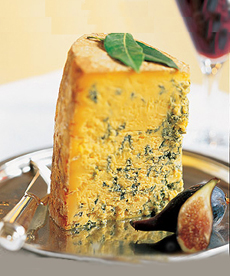 The paste of a cheese refers to the portion inside the rind. This Shropshire Blue cheese, available at McKenzieLtd.com, has a particularly beautiful paste, a light orange with veins of blue. The paste of a cheese refers to the portion inside the rind. This Shropshire Blue cheese, available at McKenzieLtd.com, has a particularly beautiful paste, a light orange with veins of blue.
May 2005
Last Updated April 2025
|
 |
|
Cheese Glossary
Types Of Cheese, Terms & Definitions Every Cheese Lover Should Know
Page 8: Cheese Terms Beginning With O & P
This is Page 8 of a 12-page glossary. Click on the letters below to find terms of interest. When you’re finished with cheese, visit our many other food glossaries.
Click on a letter to get to the appropriate glossary page.
a b c d e f g h I j k l m n o p q r s t u v w x y z
This glossary is protected by copyright and cannot be reproduced in whole or in part.
You are welcome to link to it.
OPEN
A texture description that refers to a cheese containing openings and holes in its body. It is the opposite of close. See also eyes.
PANIR or PANEER
|
Panir is an Indian fresh curd cheese that looks like ricotta, although it is very different and actually similar to the Latin American queso blanco. It is used in sweet and savory dishes. All cheese starts off with the addition of a coagulant (curdling agent) to milk that has been brought to a boiling point. With many cheeses, an enzyme, rennet, is used to coagulate the milk proteins, but the whey proteins (albuminous proteins) don’t coagulate. They are drained and can be used to make ricotta. Panir is made by adding an acid reagent to the milk (vinegar, lemon juice, yogurt, citric acid, or cultured buttermilk) rather than rennet. When the milk curdles, both the milk proteins and the whey proteins coagulate. The cheese is usually pressed until firm and, like ricotta, can be eaten fresh and raw. But unlike ricotta, panir holds its shape and can also be grilled, pan-fried, barbecued, or deep-fried.
|
|
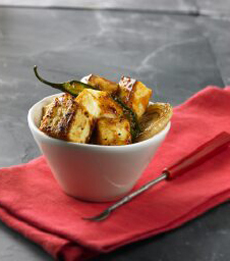
Cooked cubes of panir. Photo courtesy of
Wisconsin Milk Marketing Board.
|
PARAFFIN
Many cheeses, particularly those destined for export markets, are coated with paraffin wax to protect them. Edam, covered in bright red wax, is probably the best-known example.
PARMIGIANO REGGIANO or PARMESAN CHEESE
|
Parmigiano-Reggiano is a hard-textured cheese that is cooked but not pressed. It has been described by connoisseurs as the King of Cheeses (and wine collectors enjoy it with big wines like Barolos and Barbarescos). It is made from raw cow’s milk that is partially skimmed by gravity. Traditionally, cows have to be fed only on grass or hay. The cheese is aged for an average of two years. The name is trademarked, and in Italy, there is a legal exclusive control exercised by the Parmigiano-Reggiano cheese Consorzio over its production and sales.
|
|
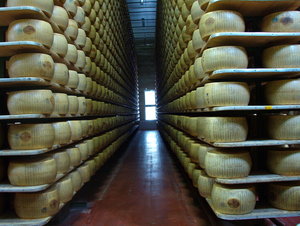
Aging wheels of Parmigiano Reggiano. Photo courtesy of Wikipedia.org. |
Each wheel of cheese must meet strict criteria early in the aging process, when the cheese is still soft and creamy, to merit the Consorzio’s official seal and be placed in storage for aging. Cheese that fails to meet these criteria is removed. The whey, which is a by-product of cheese making, is fed to the pigs that produce Prosciutto di Parma. Parmigiano-Reggiano is a D.O.P. protected trade name. Parmigiano-style cheeses that are made outside of the Emilia-Romagna and Lombardy regions of Italy, and outside the jurisdiction of the Consorzio, anywhere in the world, are called Parmesan. Read more about Parmigiano-Reggiano.
PASTA FILATA CHEESES
Pasta filata, or spun paste, refers to a family of cheeses, mostly Italian, that are cooked and kneaded, or “spun.” The cheeses range from very fresh to hard grating cheeses and include mozzarella, provolone, and scamorza.
|
|
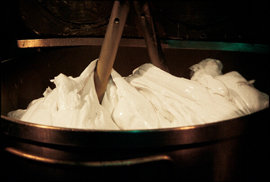
Mozzarella being “spun.” Photo courtesy of Wisconsin Milk Marketing Board.
|
PASTE or PÂTÉ
The interior body (non-rind portion) of the cheese. It is described by its texture, density, and color. When milk is too low in beta carotene, producing pale cheese, the vegetable dye annatto can be added to the curds to give the paste more color.
Cowgirl Creamery’s Mt. Tam has a light gold, semisoft paste with eyes.
|
|
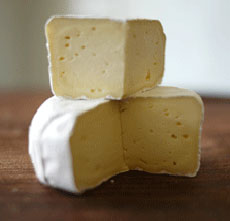 |
PASTEURIZATION
|
Pasteurization kills all bacteria in milk—beneficial as well as harmful bacteria. Because the beneficial bacteria add flavor to the cheese, many cheesemakers prefer to use raw milk. However, in the U.S., due to health concerns, raw milk cheeses must be aged for 60 days so any harmful bacteria will be killed. In pasteurization, the milk is heat treated to a specified temperature for a specified time: 145°F for 15 minutes (heat treatment) or 185°F for 15 seconds (flash pasteurization). The heat kills off all the microbial life in the milk—bad as well as good bacteria—making a clean medium for the starter culture. However, pasteurization also kills many of the natural enzymes in the milk that create flavor complexity, which is why many connoisseurs prefer raw milk cheeses—and cheesemakers prefer to make them. See also raw milk cheeses.
|
|
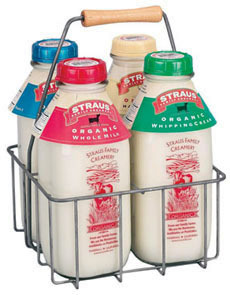
Pasteurized milk from Straus Farms, one of America’s finest family dairies and the first all-organic dairy. They still sell milk the old-fashioned way: not homogenized, so the cream floats to the top (“cream top”). |
PECORINO
|
Pecorino derives from the Italian word for sheep, pecorino. There are three main types of pecorino, all made from sheep’s milk: Pecorino Romano (originally made in Rome), Pecorino Sardo from Sardinia, and Pecorino Toscano from Tuscany. The first is a major Italian grating cheese, full-bodied and salty. The latter two are less salty and eaten as table cheese or in sandwiches. Don’t confuse Pecorino Romano with “Romano” cheese, a mild, domestic cow’s milk cheese made in the U.S.
PENICILLIUM
See mold.
|
|
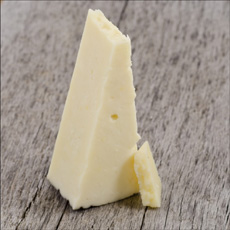
Pecorino romano, the heartiest of the pecorino cheeses. Photo courtesy of Pastoral Artisan. |
PEPPERJACK
Pepper Jack is a variant of Monterey Jack. Originally made with peppercorns, it is now typically made with jalapeño and/or habanero chile peppers, reflecting Americans’ growing interest in chile peppers over the last few decades. PERSILLE or FROMAGE À PÂTE PERSILLE
A French term for a blue-veined cheese (blue cheese). It is so named because the blue veins resemble parsley (persille in French).
|
|
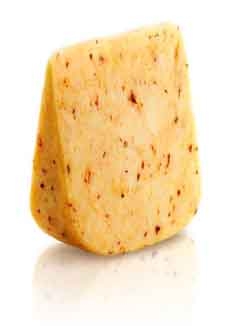
Pepper Jack cheese, with habanero chiles (photo © Eau Galle Cheese).
|
PIMENTO CHEESE
Pimento cheese is a spread or dip made with shredded Cheddar cheese, mayonnaise, chopped pimentos, and optional cream cheese. People often customize it with cream cheese, garlic, hot sauce, or jalapeños. It's typically served on crackers but often finds a place as a sandwich filling or topping for burgers and hot dogs, among other foods. In the South, it is very popular with biscuits. Here’s more about pimento cheese.
|
|
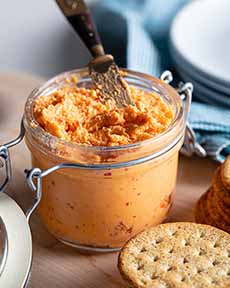
Pimento cheese (photo © Gelson’s).
|
PIQUANT
A descriptive term for a sharp-tasting cheese.
POT CHEESE
Pot cheese is cottage cheese that has been drained for a longer period of time. The resulting curd is thus much drier— the midway stage between cottage cheese and the drier, more crumbly farmer cheese. As with these other two, pot cheese is very high in protein. It’s most similar to Mexican queso blanco.
Pot cheese is popular in Jewish cuisine, where it is eaten like cottage cheese as well as used as a https://www.gelsons.com/filling for blintzes and cheese pastries. It’s also an ingredient in noodle kugel.
|
|
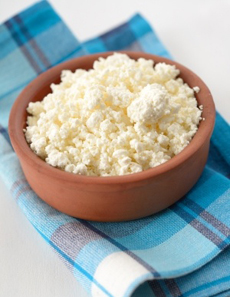
Pot cheese. Photo by Lilyana Vynogradova | 123rf. |
PRESSED, UNCOOKED CHEESES
|
One of the largest groups of cheeses, pressed, uncooked cheeses comprise hard and semi-hard cheeses. Thus, the pastes are generally semi-firm to firm. The most commonly recognized names in this category are Cheddar and Colby in hard cheese and Double Gloucester, Edam, and Gouda in semi-hard cheese. The curds are pressed to dispel the maximum amount of whey and lengthen the cheeses’ shelf life, since, before refrigeration and easy transport, the cheese needed to be sturdy enough to travel to market.
|
|
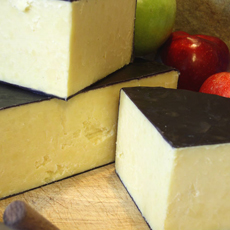
Cheddar is an example of a pressed, uncooked cheese. This English Tufton Cheddar is available at iGourmet. |
PROCESSED CHEESES
|
These are cheese by-products made from a combination of natural cheese and added ingredients, such as stabilizers, emulsifiers, and flavor enhancers. The objective is not to create artisan cheese but a consistent and shelf-stable product for mass market consumption. Cheeses in this category include American cheese, processed cheese spreads, and “cheese flavored” spreads. Velveeta, a popular product for nachos, doesn’t even have enough cheese by-product to qualify as a processed cheese: It is a “cheese food.”
|
|
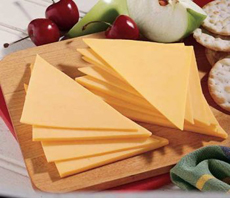
American cheese photo
courtesy of BuyCheeses.com.
|
PRONOUNCED
A descriptive term for a cheese’s aroma or flavor.
PROTECTED DESIGNATION OF ORIGIN or PDO
|
PDO is a trademark issued by the European Union. It guarantees that a product is produced, prepared, and processed in a designated geographical area, according to specified traditional practices. Purchasing a PDO cheese guarantees a consistent product experience and an established standard of excellence. A related EU term is PGI, or Protected Geographical Indication. It’s a bit less rigid than PDO: The entire product must be traditionally and at least partially manufactured (prepared, processed, or produced) within the specific region.
|
|
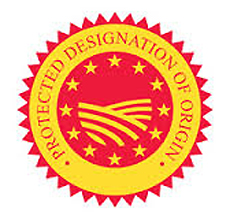
American cheese photo
courtesy of BuyCheeses.com.
|
PROVOLONE
|
A spun cheese of the Italian pasta filata group, which also includes mozzarella and scamorza. It is often found on antipasto plates. Provolone means large provola, a term that referred to buffalo milk cheese. Today it is made from cow’s milk, a semi-hard cheese that varies in flavor from mild provolone dolce to aged, sharp provolone piccante. The smaller varieties are also found smoked (affumicata). Provolone is made in unusual shapes. The most common is the salame shape shown at right, but it is also made in the shape of a watermelon, bottle, pear (mandarin), and cone. Provolone valpadana and provolone del Monaco (from the Naples area of Italy) have both received the DOP (Protected Designation of Origin) seal from the European Community.
|
|
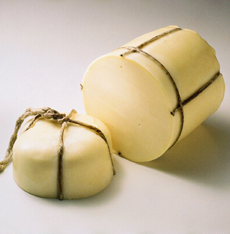
Provolone. Photo courtesy of Wisconsin Milk Marketing Board. |
Continue To Page 9: Terms Beginning With Q & R
Return To The Article Index Above
Lifestyle Direct, Inc. All rights reserved. Some material copyright Murray’s Cheese. Images are the copyright of their respective owners.

|















